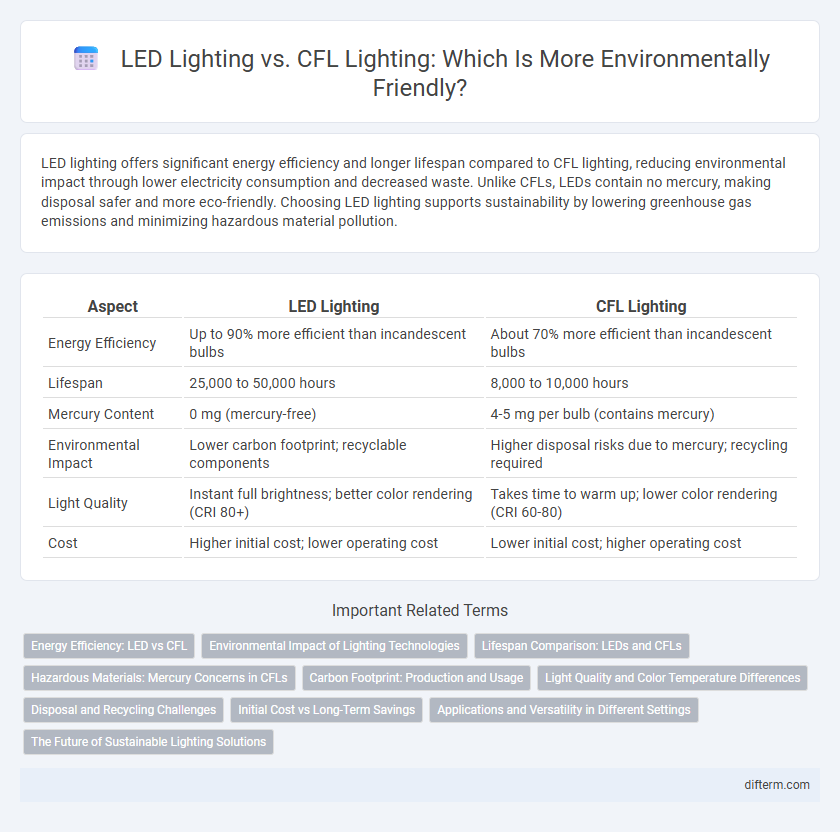LED lighting offers significant energy efficiency and longer lifespan compared to CFL lighting, reducing environmental impact through lower electricity consumption and decreased waste. Unlike CFLs, LEDs contain no mercury, making disposal safer and more eco-friendly. Choosing LED lighting supports sustainability by lowering greenhouse gas emissions and minimizing hazardous material pollution.
Table of Comparison
| Aspect | LED Lighting | CFL Lighting |
|---|---|---|
| Energy Efficiency | Up to 90% more efficient than incandescent bulbs | About 70% more efficient than incandescent bulbs |
| Lifespan | 25,000 to 50,000 hours | 8,000 to 10,000 hours |
| Mercury Content | 0 mg (mercury-free) | 4-5 mg per bulb (contains mercury) |
| Environmental Impact | Lower carbon footprint; recyclable components | Higher disposal risks due to mercury; recycling required |
| Light Quality | Instant full brightness; better color rendering (CRI 80+) | Takes time to warm up; lower color rendering (CRI 60-80) |
| Cost | Higher initial cost; lower operating cost | Lower initial cost; higher operating cost |
Energy Efficiency: LED vs CFL
LED lighting consumes up to 75% less energy compared to CFLs, making it a significantly more energy-efficient option. LEDs convert a higher percentage of electricity into visible light, resulting in less wasted energy as heat. This improved energy efficiency translates to lower electricity bills and reduced greenhouse gas emissions over the lifespan of the bulb.
Environmental Impact of Lighting Technologies
LED lighting significantly reduces energy consumption by using up to 75% less electricity than CFL lighting, leading to lower greenhouse gas emissions. Unlike CFLs, LEDs do not contain mercury, eliminating hazardous waste concerns and simplifying disposal. The longer lifespan of LEDs further decreases resource use and waste generation, making them a more environmentally sustainable lighting technology.
Lifespan Comparison: LEDs and CFLs
LED lighting typically offers a lifespan of 25,000 to 50,000 hours, significantly outlasting CFL bulbs, which average around 8,000 to 10,000 hours. The extended durability of LEDs reduces waste and replacement frequency, making them a more sustainable choice for energy-efficient lighting. In terms of environmental impact, the longevity of LEDs minimizes resource consumption and landfill contributions compared to CFLs.
Hazardous Materials: Mercury Concerns in CFLs
CFL lighting contains mercury, a toxic heavy metal that poses significant environmental and health risks if bulbs break or are improperly disposed of. LED lighting eliminates these hazards by using non-toxic components, making it a safer and more environmentally friendly option. Proper recycling of CFLs is essential to prevent mercury contamination in soil and water sources.
Carbon Footprint: Production and Usage
LED lighting significantly reduces carbon footprint compared to CFL lighting due to lower energy consumption and longer lifespan, leading to fewer replacements and less waste. The production process of LEDs involves less hazardous materials and emits fewer greenhouse gases than CFL bulbs, which contain mercury and require more energy-intensive manufacturing. During usage, LEDs consume up to 80% less electricity, resulting in substantially reduced carbon emissions over their operational life.
Light Quality and Color Temperature Differences
LED lighting offers superior light quality with greater brightness and more consistent color temperature ranging from 2700K to 6500K, providing options from warm to cool white. CFL lighting typically produces a harsher, flickering light with less accurate color rendering and a narrower color temperature range, usually around 3000K to 4100K. The precise control over light spectrum in LEDs results in better visual comfort and energy efficiency compared to CFLs.
Disposal and Recycling Challenges
LED lighting poses fewer disposal challenges than CFL lighting because LEDs do not contain hazardous mercury, making recycling safer and less complex. CFL bulbs require specialized disposal methods to prevent mercury contamination, complicating recycling processes and increasing environmental risks. Proper infrastructure for LED recycling is expanding, further reducing environmental impact compared to CFLs, which still face significant disposal and recycling hurdles.
Initial Cost vs Long-Term Savings
LED lighting typically has a higher initial cost compared to CFL lighting, but it offers significantly greater long-term savings through lower energy consumption and longer lifespan. CFL bulbs consume about 70% less energy than incandescent bulbs, yet LEDs consume up to 80% less energy and can last up to 25,000 hours, reducing replacement frequency and maintenance costs. The upfront investment in LED technology is offset by reduced electricity bills and fewer bulb replacements, making LEDs more cost-effective and environmentally sustainable over time.
Applications and Versatility in Different Settings
LED lighting offers superior versatility across diverse environments, including residential, commercial, and industrial settings, due to its wide range of color temperatures and dimming capabilities. CFL lighting is typically limited to indoor use and performs best in fixed fixtures where warm, consistent light output is desired. LED's ability to operate efficiently in outdoor, wet, and variable temperature conditions makes it the preferred choice for versatile lighting applications.
The Future of Sustainable Lighting Solutions
LED lighting offers superior energy efficiency and longer lifespan compared to CFL lighting, significantly reducing carbon emissions and waste. Advances in LED technology continue to lower production costs and improve light quality, making it the preferred choice for sustainable urban and residential environments. The integration of smart LED systems with IoT further enhances energy management, positioning LED lighting as the cornerstone of future eco-friendly illumination strategies.
LED lighting vs CFL lighting Infographic

 difterm.com
difterm.com